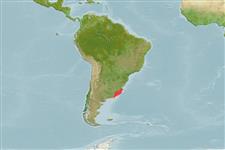Teleostei (teleosts) >
Clupeiformes (Herrings) >
Clupeidae (Herrings, shads, sardines, menhadens)
Etymology: Ramnogaster: Greek, rhamnos, -on = blackberry + Greek, gaster = stomach.
Eponymy: Reverend Leonard Jenyns (1800–1893) was a clergyman and amateur naturalist. [...] (Ref. 128868), visit book page.
More on author: Jenyns.
Environment: milieu / climate zone / depth range / distribution range
Ecology
Marine; pelagic-neritic; depth range 0 - 50 m (Ref. 188). Subtropical; 33°S - 42°S, 64°W - 52°W (Ref. 188)
Southwest Atlantic: southern Brazil (estuary of the Lagoa dos Patos) and Uruguay to at least Bahía Blanca, Argentina; some of the more southerly records (even to the Beagle Channel) must refer to Sprattus fuegensis.
Size / Weight / Age
Maturity: Lm ? range ? - ? cm
Max length : 9.0 cm SL male/unsexed; (Ref. 188); common length : 7.5 cm SL male/unsexed; (Ref. 188)
Dorsal spines (total): 0; Dorsal soft rays (total): 18 - 19; Anal spines: 0; Anal soft rays: 12 - 23. Belly sharply keeled. Flanks silvery without a distinct silver stripe (cf. Platanichthys). Distinguished from R. melanostoma of freshwaters by having more dorsal and pectoral fin rays and total gill rakers; from small Sardinella and Harengula by the evenly rounded hind margin of the gill opening; and from Sprattus fuegensis by having i 6 pelvic fin rays.
Forms schools in coastal waters, apparently inshore but not entering freshwater.
Life cycle and mating behavior
Maturity | Reproduction | Spawning | Eggs | Fecundity | Larvae
Whitehead, P.J.P., 1985. FAO Species Catalogue. Vol. 7. Clupeoid fishes of the world (suborder Clupeoidei). An annotated and illustrated catalogue of the herrings, sardines, pilchards, sprats, shads, anchovies and wolf-herrings. FAO Fish. Synop. 125(7/1):1-303. Rome: FAO. (Ref. 188)
IUCN Red List Status (Ref. 130435: Version 2024-1)
Threat to humans
Harmless
Human uses
Fisheries: minor commercial
Tools
Special reports
Download XML
Internet sources
Estimates based on models
Preferred temperature (Ref.
123201): 11.7 - 18.3, mean 15.7 °C (based on 74 cells).
Phylogenetic diversity index (Ref.
82804): PD
50 = 0.7500 [Uniqueness, from 0.5 = low to 2.0 = high].
Bayesian length-weight: a=0.00676 (0.00339 - 0.01349), b=3.13 (2.95 - 3.31), in cm total length, based on LWR estimates for this (Sub)family-body shape (Ref.
93245).
Trophic level (Ref.
69278): 3.1 ±0.1 se; based on size and trophs of closest relatives
Resilience (Ref.
120179): High, minimum population doubling time less than 15 months (Preliminary K or Fecundity.).
Fishing Vulnerability (Ref.
59153): Low vulnerability (10 of 100).
